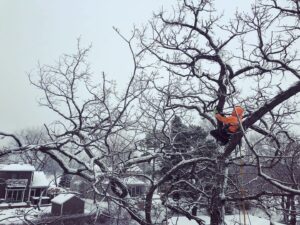Blizzards, snow and ice are synonymous with a typical Minnesota winter.
It’s never surprising to turn on the morning or evening news and hear the weather reporter warning viewers about upcoming snowfall or poor weather conditions. The average snowfall per year in the greater Minneapolis, MN area is upwards of 54 inches.
These ice storms, snow squalls, and blizzards can definitely make it challenging to drive to school or work along with damaging phone and power lines. These storms do more than dump a pile of snow for us to shovel. They can also cause severe damage to the trees on our property.
It is not uncommon for a vulnerable tree limb to snap off, and come crashing to the ground while under the weight of ice and snow. These branches often hang overtop of our homes, garages and vehicles, which poses a very dangerous situation if they break. This could cause significant property damage that could’ve been preventable.
Fortunately there are ways we can keep our trees safe and intact during the snowy and icy winter months.
Best Tips To Protect Your Trees During Winter
There are many ways to protect your trees from the potentially damaging effects of the winter elements. Both large and small trees require preventative measures to ensure they are protected throughout the winter.
 Protection Against Heavy Snowfall
Protection Against Heavy Snowfall
Heavy snowfall can lead to weak branches snapping under the weight of the snow. It’s important to gently brush off the excess snow, but do not vigorously shake the tree branch to do so. The aggressive shaking can cause an already stressed tree branch to break. The sudden loss of weight can also cause the branch to snap back and damage the internal circulatory system.
One of the most effective ways of preventing damage from heavy snowfall is to have a professional tree care specialist identify weak branches and intervene early in the season. This preventative tree care maintenance ensures your tree will be able to sustain the stress of a heavy winter snowfall.
Protection Against Ice Storms and Ice Build Up
Ice storms can cause a build up of ice on tree branches, making them very heavy and prone to breaking. It may seem like a good solution to break off or chisel away the frozen ice, but doing so will only further damage your tree. Instead, wait for the ice to melt then inspect the tree for cracks or damage to limbs and trunk.
If you encounter anything potentially threatening to your tree, it’s best to contact a professional to determine the appropriate course of action.
Again, the best way to protect your tree from ice build up is through preventative maintenance. A trained arborist will be able to identify potentially weak branches that can be trimmed in order to strengthen the overall tree. A strong, healthy tree is the best defense against ice storms and ice build up.
 Protection Against Blizzards
Protection Against Blizzards
Blizzards don’t just bring heavy snowfall, they also bring low temperatures and high winds. These strong winds can cause weakened tree branches to break under the force of the gusts. When a tree sustains this type of damage, it can be hard for them to heal, especially in such frigid temperatures.
One of the best ways to help protect your tree from the strong winds blizzards blow in, is to cable and brace your tree. This involves having a professional tree care specialist identify branches that may be susceptible to breaking under high winds. These branches can then have a cable attached to them and anchored to the trunk. This provides additional stability to the branch, keeping them from breaking in the winter elements.
Protection Against Sun Scald
The sun may not seem as strong in the winter, but the effects are still seen especially in trees. During sunny days, the sun warms and softens the bark on the outside of the trunk. When the temperature drops back down at night the bark freezes, over time this causes fissures in the trunk, damaging the protective layer of the tree. This same process can affect the roots that lay closest to the surface of the soil.
Young trees are particularly susceptible to sun scald. The best defenses against sun scald:
- Mulching – This added layer of wood chips, protects the roots and the trunk base from the constant thawing and freezing.
- Wrapping Trees – The best material is a white or silver to reflect the sun protecting the trunk from damage. If you do use wraps it is important to inspect them regularly to ensure the trunk has not sustained any damage from the wraps themselves.
Twin Cities Tree Care Experts
If you have experienced any tree damage or are looking for preventive maintenance to ensure the longevity of your trees in the greater Twin Cities Area, contact the tree care professionals at Pro-Tree Outdoor Services. With over a decade of experience, our trusted team members will keep your trees growing for years to come.


Write a Comment